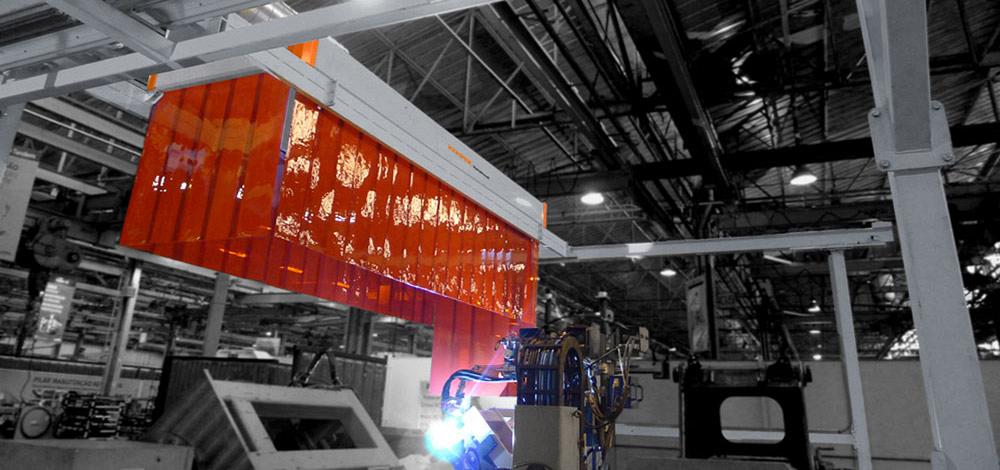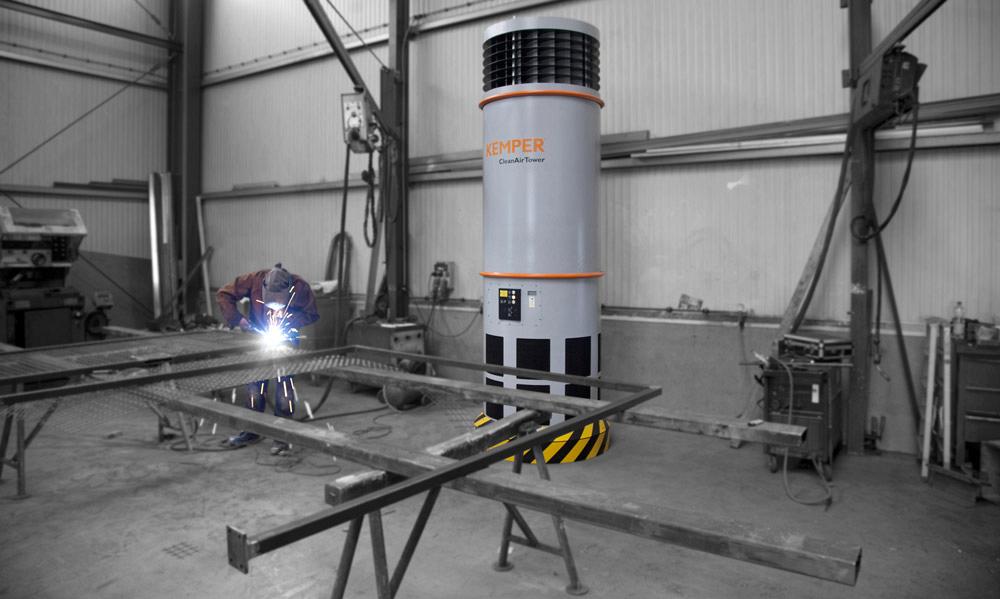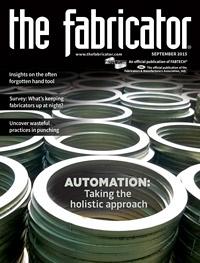President
- FMA
- The Fabricator
- FABTECH
- Canadian Metalworking
Categories
- Additive Manufacturing
- Aluminum Welding
- Arc Welding
- Assembly and Joining
- Automation and Robotics
- Bending and Forming
- Consumables
- Cutting and Weld Prep
- Electric Vehicles
- En Español
- Finishing
- Hydroforming
- Laser Cutting
- Laser Welding
- Machining
- Manufacturing Software
- Materials Handling
- Metals/Materials
- Oxyfuel Cutting
- Plasma Cutting
- Power Tools
- Punching and Other Holemaking
- Roll Forming
- Safety
- Sawing
- Shearing
- Shop Management
- Testing and Measuring
- Tube and Pipe Fabrication
- Tube and Pipe Production
- Waterjet Cutting
Industry Directory
Webcasts
Podcasts
FAB 40
Advertise
Subscribe
Account Login
Search
A welding ventilation overview
Removing the invisible threats in welding fumes is one of the necessary functions of ventilation equipment
- By Benjamin Howell
- August 25, 2015
- Article
- Safety

Figure 1
Integrated lighting devices inside extraction hoods are
designed to improve the visibility of the workpiece,
which allows welders to adjust the hood more effectively.
Welding emission reduction is something that interests all metal fabricators, and today’s welding technology does a good job of removing welding smoke that can contribute to health risks. This can be misleading, however.
At the nanolevel, invisible to the human eye, the concentration of particulate matter can pose a great risk to welders. Studies show that welding fume particles are mostly smaller than 0.1 micrometer, which makes nearly all welding fume particles respirable. They can penetrate deep into the alveolate region of the lungs during inhalation and remain firmly fixed there.
Welders exposed to welding fumes on an ongoing basis run a significant risk of health-related problems. The most common symptoms include fatigue, breathing difficulties, shortness of breath, bronchial diseases, manganese poisonings, lead and cadmium oxides, episodes of metalworkers’ fever when welding galvanized materials, and even damage to the central nervous system. The harmful particulate matter generated during welding of nickel, chromium, and cadmium compounds can be considered carcinogenic.
Additional health risks are associated with filler materials. Ninety-five percent of harmful substances that make up welding particulate originate from the filler metal, and only the remaining 5 percent comes from the parent metal.
What safety measures should be employed to protect metal processing workers from such risks?
Conducting a Risk Assessment
When looking for an adequate extraction and filtration system, a metal fabricator should have a risk assessment done to investigate all the involved risks and working conditions more closely.
The first question in a risk assessment focuses on what materials and welding procedures are used. Gas metal arc welding (GMAW) and arc welding with coated rod electrodes demonstrate the highest risk potential for producing dangerous particulate matter. The most hazardous particulates are generated in welding processes involving chrome-nickel steel.
Proper ventilation measures should be used for processes with at least a medium hazard class rating as well. This includes gas tungsten arc welding (GTAW) of toxic and irritant materials, such as manganese and copper oxides.
Using a different filler material when welding can help to mitigate the risk, but metal fabricators should use extraction and filtration systems to eliminate as much harmful particulate matter from the ambient air as possible. This is particularly true as materials and welding procedures can change over time.
At-the-source Welding Fume Extraction
With the potential hazards identified from the assessment, the fabricator can turn to controlling emissions. The most important factor when using clean air technologies is this: Welding fumes should be contained at the point of origin.

Figure 2
When a ventilation hose is incorporated into the welding torch, the welder doesn’t have to worry about adjusting an
extraction hood when changing positions.
When properly used, indirect capture methods can help to prevent the spread of harmful substances in the ambient air. Low-powered vacuum source extraction systems are used most frequently in manufacturing settings (see Figure 1). They capture harmful substances with the use of extraction hoods and flexible extraction arms at a distance of about 1 foot from the point of origin. The extraction arms, connected via the extraction and filtration system or the pipe system to the central ventilation system, are self-supported devices.
Extraction systems integrated into welding torches, connected directly to the welding gun (see Figure 2), and funnel- or slit-shaped, high-powered vacuum source extraction systems that are held in place by magnets offer an alternative to low-powered vacuum source extraction systems.
In automated welding, extraction hoods with large lateral coverage provide protection against crossflows (see Figure 3). The size depends on the operating area of the robotic welding cell.
Welding Fume Extraction for Larger Areas
Source extraction systems are frequently pushed to the limit when used in conjunction with the welding of large workpieces at multiple sites. Welders might not put the ventilation device in the right position, or they simply can’t reach a particular area of work.
Worker safety can be maintained in these cases with room ventilation systems in addition to source extraction systems (see Figure 4). They also help to protect nonwelders in the production facility from exposure to harmful substances and improve the quality of air in the working area.
Welders who have their heads buried in welding fumes should consider additional respiratory protection equipment. For instance, a welding helmet with an autodarkening filter can be provided with an attached ventilation unit.
To ensure further industrial safety, a metal fabrication facility should consider high-quality filtration for recirculated air from room ventilation equipment. This type of filtration ensures that the air supplied from the filtration system can be recirculated into the working area without the presence of dust.
For example, metal fabricators should use only filters that offer the highest efficiency when welding chrome-nickel steel. The filters should be certified to remove 99 percent of particulate matter from the air. (In Europe, these are designated W3-certified filters.)
This recirculation of air also can contribute to energy savings in the winter because the shop is not required to heat the air from the ventilation equipment; it has been heated already upon discharge from the equipment.
Focus on Efficiency
The discussion of industrial safety should not be limited to costs because a safer work environment can be linked to increased worker productivity as well.

Figure 3
Ventilation hoods for automated welding applications can be stationed on mounts around the cell or suspended above to offer more open space on the shop floor.
Workers that are effectively protected against inhaling hazardous particles do not display as much fatigue or shortness of breath as workers exposed to welding fumes on a continuing basis. In the long run, those working in industrial environments with clear air also are less likely to suffer from bronchial diseases, manganese poisoning, and other illnesses that might affect them in dirtier work environments.
Healthy workers have fewer job interruptions and health-related absences. They also are likely to have higher rates of job satisfaction.
Benjamin Howell is president, Kemper America, 5910 Shiloh Road East, Suite 114, Alpharetta, GA 30005, 800-756-5367, www.kemperamerica.com.
Risks at the microlevel
Dust particles can be divided into three groups according to their size:
1. Dust particles up to 100 micrometers (µm), which were formerly classified as “total dust.”
2. Particles less than 10 µm, which includes particulate matter that penetrates the pulmonary vesicles (alveoli) and can accumulate there.
3. Particles smaller than 0.1 µm, which also are called ultrafine particles. Of all welding fume particles, 98.9 percent are less than 0.4 µm in size.
Checklist:
Factors inf luencing fume extraction device selection
- What’s the top priority? Extraction of harmful particulate matter at the point of origin is best done with an extraction arm or a device integrated into the welding gun.
- What is the size of the workplace? Knowing the proper length and layout of extraction arms is crucial to covering the entire working area without interfering with other operations and material transportation.
- Can welders easily operate the extraction arms? Simple operation helps to increase welders’ acceptance level, and welding quality can be improved by the use of lighting devices inside the extraction hood.
- What is the typical position of the welder’s head and body in relation to the source of emissions? Extraction hoods must be arranged so that the fume impact region never enters the breathing zone.
- Does the welder have the proper face protection? When using autodarkening welding helmets, welders have a free hand. This allows them to adjust the extraction hood more easily.
- Which welding materials are being used, and what are the welding procedures? The proper filters and filtration equipment can be chosen based on the answers to these questions.
About the Author
Benjamin Howell
1110 Ridgeland Pkwy, Suite 110
Alpharetta, GA 30004
770-416-7070
Related Companies
subscribe now

The Fabricator is North America's leading magazine for the metal forming and fabricating industry. The magazine delivers the news, technical articles, and case histories that enable fabricators to do their jobs more efficiently. The Fabricator has served the industry since 1970.
start your free subscription- Stay connected from anywhere

Easily access valuable industry resources now with full access to the digital edition of The Fabricator.

Easily access valuable industry resources now with full access to the digital edition of The Welder.

Easily access valuable industry resources now with full access to the digital edition of The Tube and Pipe Journal.
- Podcasting
- Podcast:
- The Fabricator Podcast
- Published:
- 04/16/2024
- Running Time:
- 63:29
In this episode of The Fabricator Podcast, Caleb Chamberlain, co-founder and CEO of OSH Cut, discusses his company’s...
- Industry Events
16th Annual Safety Conference
- April 30 - May 1, 2024
- Elgin,
Pipe and Tube Conference
- May 21 - 22, 2024
- Omaha, NE
World-Class Roll Forming Workshop
- June 5 - 6, 2024
- Louisville, KY
Advanced Laser Application Workshop
- June 25 - 27, 2024
- Novi, MI
































